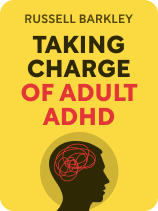

This article is an excerpt from the Shortform book guide to "Taking Charge of Adult ADHD" by Russell Barkley. Shortform has the world's best summaries and analyses of books you should be reading.
Like this article? Sign up for a free trial here.
Is medication enough to handle ADHD? What extra steps should you take to get your ADHD under control?
Though medication is your first line of defense against ADHD, you’ve probably developed unhelpful behavior patterns because of your ADHD symptoms. Once your medication has begun to do its work, you may want to try to develop new habits to counter the ones ingrained by ADHD.
Here’s how to manage ADHD as an adult using behavioral methods.
Behavioral Strategies to Manage ADHD
Russell A. Barkley provides tips on how to manage ADHD as an adult to retrain your brain. These include learning to pause before acting, using visualization techniques to better understand the flow of time around you, and taking advantage of some cognitive tricks to give you a leg up on planning and problem-solving.
(Shortform note: Before delving into Barkley’s suggestions for changing the habits ingrained by ADHD, let’s take a moment to look at habits themselves. Most psychologists describe habits as something you do without thinking because the behavior is programmed into your brain. A “cue” or “trigger” starts the program running, such as the smell of coffee igniting your desire for your first cup of the day. The cue is followed by an automatic action, such as filling your cup from the office coffee maker. Lastly, your brain gets a reward that reinforces your behavior, which can either be something pleasurable or a relief from pain or fear. For habits formed because of ADHD, the reward is often a dopamine rush that counters your brain’s chemical deficiency.)
1. Taking a Pause
The first trick to overcoming ADHD-influenced habits is to find ways to pause and reflect in situations where you’re used to behaving impulsively. As a person with ADHD, you may find that easier said than done. Barkley acknowledges that trying to fight your impulse to act isn’t likely to work, so instead he suggests that you think about ways to redirect that impulse when it happens. If you can satisfy your reactive urge by deflecting it into a harmless action, such as scratching your head or tapping your fingers, that momentary pause might give you time to consider the most appropriate course of action to take next.
(Shortform note: When you pause to consider your actions, you actively switch your brain’s mode of thinking. In Thinking, Fast and Slow, Daniel Kahneman defines your brain’s two modes as System 1 (automatic) and System 2 (effortful). System 1 thinking, often involuntary, generates suggestions, feelings, and intuitions for System 2 to approve or turn down. If endorsed by System 2, impulses turn into voluntary actions. The problem is that even for neurotypical people, System 2 thinking has a limited attention budget—you can only think about so many things at once. Because of this, you can’t force yourself to “think better.” All you can do is find ways to reduce your cognitive load—such as by taking Barkley’s advice to pause.)
This form of redirection will be hard to come up with on the spur of the moment, so Barkley suggests that you take time to identify impulsive patterns in your past and practice a counter-habit in advance so you can use it when it counts. For example, during conversations, you might instinctively interrupt other people whenever a new idea pops into your head. However, this behavior could easily strain relationships with your friends and coworkers. If this sounds familiar, then before the next time you feel the urge to cut someone off mid-sentence, you might decide to redirect that energy by taking a slow breath, placing your hand over your mouth, or paraphrasing what the other person just said.
(Shortform note: Barkley’s advice to create counter-habits reflects the idea that it’s easier to replace a habit with a new one than to stop a habitual reaction completely. In Atomic Habits, James Clear says to do this, you should maximize the appeal of the behavior you want, such as not interrupting someone in a conversation. Two ways to approach this are to associate the new habit with other, positive behaviors—such as connecting with others more deeply—and reframing the challenge the new habit presents in a positive light—such as looking forward to what the other person has to say more than voicing your thoughts as soon as you have them.)
2. Visualization
Of course, being able to see behavior patterns in your past and planning what to do about them in the future are two things that ADHD sabotages, as we discussed earlier in this guide. This makes it hard to analyze the past and predict the results of your actions in the future. Therefore, Barkley recommends visualization techniques that can strengthen your memory’s muscles. These range from adopting useful visual cues, exercising your different types of memory, and imagining the positive outcomes of your efforts.
The most difficult time to tap into memory is when you’re in the midst of challenging situations, so first let’s cover what you can do to help control your actions in advance. Barkley’s advice is to externalize your memory and use visual reminders to guide your choices. For instance, if you struggle with being on time for appointments, place a brightly colored sticky note in your line of sight to serve as a reminder. Another way to make your memory visual is to record anything you need to remember in a journal, including important dates, deadlines, and commitments you’ve made to other people. To reinforce the habit of consulting your journal, you can set an alarm on your phone or computer—another form of externalized memory.
3. Motivation and Problem-Solving
Not being able to envision the future creates real problems for people with ADHD, especially when it comes to motivation and problem-solving. As with navigating your challenges around short-term impulse control and decision-making, planning for the future requires activating the higher functions of the brain that ADHD normally suppresses. Tricks to jump-start a recalcitrant brain include visualizing positive outcomes, breaking tasks down into manageable chunks, and involving all of your senses in problem-solving, not just trying to work from pure imagination.
The trouble with trying to change your behavior is that it takes time to see any results, and as a person with ADHD, you may grow impatient with your progress or worse—you might start to beat yourself up for not being able to see results fast enough. This is why Barkley says it’s important to imagine the positive consequences that will result from engaging in productive behaviors. This can help generate uplifting emotions that motivate you to take the necessary steps to achieve your goals.
This advice doesn’t only apply to managing your ADHD, but also to achieving any of the goals that your ADHD symptoms may have hindered. For example, if you want to write a book but have trouble getting started, imagine how good it will feel to hold a published copy in your hand. Barkley writes that to amplify your positive emotions, you can use visual cues as reminders of how much you’ll enjoy achieving your goals, similar to the reminders you might use to keep yourself on track for your short-term tasks. For instance, if you aspire to run a marathon and need visual motivation to train, create a mockup of the medal you might win once you’ve finished the race.
4. Accept Your ADHD
No matter what medications and lifestyle strategies you find useful, Barkley is adamant that to truly manage your ADHD, rather than letting it manage you, is to accept that your ADHD is part of who you are as a person. This doesn’t mean you should accept it as a gift, but neither should you ever feel ashamed about your diagnosis. If you acknowledge it as one of your imperfections, of which we all have many, then you’ll be able to work with your condition, rather than wasting fruitless time working against it.
(Shortform note: Avoiding shame is the key benefit Barkley stresses from accepting ADHD. In The Gifts of Imperfection, Brené Brown defines shame as the feeling that you don’t deserve to be loved because you’ll never be “good enough.” The counter to shame is feeling worthiness, the conviction that you are good enough as you are, flaws and all. Brown’s recipe for learning resilience against shame includes being and accepting your true, authentic self and refusing to compare yourself to others. This advice can be hard to follow if you’re used to feelings of inadequacy for being neurodivergent, but Brown insists that accepting who you are as a person will help you develop a sense of inner strength and resilience against future feelings of shame.)
Barkley says you might find it helpful to approach your ADHD with a sense of humor. Though this, like any other strategy, may not work for everyone, being able to laugh at your struggles can help you maintain a positive attitude as you navigate the challenges arising from your symptoms. If you can face difficulties related to ADHD and are able to find humor in the situation, you’ll avoid fixating on your mistakes, being self-critical, and becoming mired in negative self-judgment. Ultimately, this approach can empower you to maintain resilience and focus on moving forward.
(Shortform note: In saying you can face your ADHD with humor, Barkley isn’t suggesting that you should see your condition as funny—rather, that you can reframe your struggles in a way that can make living with them easier. Though Barkley doesn’t draw the connection himself, some of his advice about adopting a helpful mindset is in line with classic Stoic philosophy. In The Stoic Challenge, William B. Irvine explains that when encountering problems—such as those of living with ADHD—you can frame them as opportunities to practice resilience, resolve, courage… and humor. This lets you maintain emotional equilibrium by choosing to respond rather than to react, so you can face ADHD’s challenges on your own terms.)

———End of Preview———
Like what you just read? Read the rest of the world's best book summary and analysis of Russell Barkley's "Taking Charge of Adult ADHD" at Shortform.
Here's what you'll find in our full Taking Charge of Adult ADHD summary:
- The various treatment options for ADHD in adults
- How to accept ADHD as a part of your life
- What ADHD can look like in undiagnosed adults






